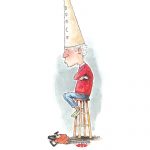Mama’s House
Somewhere down the dirt road of memory
By Bill Thompson
We sold Mama’s house a little while back, just before she died. We realized that she wasn’t coming back from the nursing home and she told us to sell it. So, as always, we did what Mama told us to do.
Of course, I miss the house. It’s where I grew up. It held all those memories of family and friends that made up my life for almost 20 years. But it has also released those memories now to run rampant through my mind, to pop up unexpectedly. It is right next door to the Hallsboro Baptist Church, which I still attend, so I see the house at least once a week, and as I walk from the parking lot to the church, I can’t help taking a look at the old house. I try not to get too sentimental about it. Good folks live there now and, frankly, it only takes a minute to walk across the parking lot, so I don’t have a lot of time to think about the past right then.
But sometimes when I’m driving through rural North and South Carolina, I’ll see something that will make me think of the little house in Hallsboro back in a different time. The late 1940s and ’50s were great years for most of us. A world war had ended, family members had come home from fighting in places we had never heard of before the war, and prosperity was knocking on every door.
A surefire trigger for memories is a dirt road. Admittedly, I don’t travel on them much anymore, mainly because there aren’t many left. I was coming home from Southport the other day and took a voluntary detour down a dirt road I hadn’t been on in a long time. It had rained just enough to settle the dust and not create a boggy mess.
Driving on a dirt road that wasn’t dusty made me think of Mama’s house. I remember her fussing about all the dust that arose from the road in front of the house. There was not a lot of traffic on the road, about as many mules and wagons as automobiles, but to Mama each car intentionally created dust that would seek out the open windows during the hot summer days and settle on her furniture. One of my first chores was dusting furniture.
When I was thinking about writing this story, I called the department of transportation in Whiteville to find out when the Hallsboro road was first paved. Mr. Kenneth Clark, the district engineer for the Division of Highways, very kindly looked it up and gave me a history of the road. It was not until about 1955 that the whole road was paved with asphalt. Other substances had been used but not what we now call permanent pavement.
There were plenty of children in Hallsboro back then, and my sister Linda’s closest playmates lived just on the other side of the churchyard from our house. Mrs. Bernice Ray was on the corner of the dirt street, and Paul and Maude Wyche lived in the house beside her. They later moved to a bigger house just through the woods behind our house. There was no parks and recreation department in Hallsboro then or now, but the churchyard was big and grassy and had a dirt driveway and a few spindly young cedar trees. That was our playground. We made up games to fit the number of people in the churchyard. A few years ago, the church underwent some significant repairs and several softballs, baseballs, footballs, round rubber balls of various sizes, remnants of kites and other similar items were recovered from the crevices of the church roof.
Our house was the next to the last house before you left Hallsboro going north. My Aunt Lucille lived in the last house right beside ours. Past her house was all woods and ditches and dirt road, a kind of extension of our playground. As I was driving down the dirt road coming from Southport, I saw two boys squatting down next to a ditch that ran off into the woods from the dirt road. I don’t know what they were doing, but sometimes Paul and I would look for crawfish in the ditches. We probably found some, but I don’t know what we did with them. I’m pretty sure we didn’t eat them. Sometimes we’d find minnows in a pool in one of the ditches. We’d take them home, nurture them, then give them full burial rites the next day.
There are not very many good memories of Hurricane Hazel remembered by folks who lived through that tragedy. But for my playmates and me in Hallsboro, Hurricane Hazel added to our recreation area by creating some of the most elaborate “forts” and “camps” you can imagine. Picture large oak trees and pine trees slain by the hurricane, the giant roots coated with mud and the fallen treetops forming ladders parallel to the ground. When the mud dried it created an abundance of ammunition for dirt fights between the fallen forts.
As I write this, I realize I haven’t written anything about Mama’s house except its location. Maybe that’s because growing up in a small rural town in the South in the middle of the 20th century was a great time to be alive, a story all its own. Maybe it is because the house was just one part of the great adventure we created with our imaginations. Imagine that . . . dust and all.
Bill Thompson is a regular Salt contributor. His newest memoir, Tuxedos & Pickup Trucks, is available on Amazon and wherever books are sold.


